#testing since 1947
Explore tagged Tumblr posts
Text




Source: Ltc. Harry Welsh's file (Transcript under the cut)
Exhibits A, B, and C: Harry Welsh being the prime example of "if he wanted to, he would."
When the war broke out, I tried to join the submarines, but I was rejected because I didn't have 20-20 vision. Then I tried to become a fighter pilot or a parachutist but was turned down by both for the same reason. So, I joined the infantry and completed basic training. Since I did well in basic, I was offered a chance to become an officer or join the parachute troops. As we were given physicals, I kept dropping back in line and asking my friends to get letters on the 20-20 line of the eye chart. This they did, I memorized the letters and passe[d] the vision test with flying colors. Given the choice of the parachute school or officer training, I chose the parachutists.
After our honeymoon, I looked for work, but couldn't find a good paying job because I wasn't a college graduate. Thus, I went back to my old job at the courthouse where I eventually worked my way up to Director of the Tax Claim Bureau. I needed a college education to advance myself so I entered night school in 1947. Ten years later I graduated with honors at the age of 39.
Yet, with this background, I had and still have great love for my country, and I am unbelievably in love with my wife.
LTC. Harry Welsh
#happy birthday to my 5'7 guy <3#harry welsh#fellow member of the “i can survive anything as long as i have a crush” club#real yearners recognize real#band of brothers#easy archives
78 notes
·
View notes
Text
The slow but incessant rain of anvils began in 1942.
George Macomber was walking from the trolley stop to his home in Great Falls (a name which many newspapers took advantage of in their lede selection) when a two-ton Bavarian fell out of the sky, landing squarely on top of poor George. He was Flattened instantly.
And, seconds later, he slid out from beneath the anvil, with a new height of one and a half millimeters. He had become, in an instant, the densest human being on the planet.
George Macomber happened to look up just before impact. This saved his life: because he was the first to ever be Flattened, the extremely-high-density intravenous fluid setup had not yet been invented, and no hospital could have kept him hydrated if his mouth were not accessible on his topside. (Iris Colelman invented the extremely-high-density intravenous setup in 1947, after hundreds had perished due to dehydration mere days after their Flattening.)
In another twist of good fortune, George Macomber had served as a signal officer in the Navy during the Great War and knew Morse code. While his vocal chords were capable only of producing an awful gurgling, he could still communicate by blinking - a trick that the doctors recognized quickly. And so he was able, painstakingly, to describe the characteristic sound of the anvil's descent: a terrifying descending whistle, like the slide-flute sound used for falling bombs in animated reels.
His story is not all a happy one, though. Some who are Flattened eventually pop back up to their former stature, but poor Mr. Macomber never did. While his medical condition remained stable, his wife divorced him and he had trouble finding employment. Seven years after his Flattening, he stopped eating or drinking. His final words, blinked to his nurse, are lost to history; she felt that she owed him her silence, even as she was fired and eventually prosecuted for letting him pass in this manner. The court asserted that she should have immobilized him and given him a high-density drip.
Only twenty-three days after George's Flattening, Irma Childress was returning from the bakery when a six-ton farrier's anvil hurtled down and Flattened her. She, too, was lucky enough that her mouth remained accessible. Her story is happier than George's - she was also the first person to pop back up to her normal height. It took her six months, and those must have been worse than George's, as she did not know Morse code - though she learned it and was proficient by her third Flattened month.
Even after regaining her former height, Irma remained wary of doors, stairs, and any place with high foot traffic. She sold her house in Los Angeles and moved out to an almond farm. She spoke to the press repeatedly and respectfully, and to this day is remembered as an early and passionate advocate for keeping the Flattened comfortable and helping them maintain their dignity.
Nobody has discovered where the anvils come from. They fall primarily in North America, most often in the southwest and midwest. Some suspect that they are flung by tornados, or some sort of awful prank, or military test flights. They are always of recent manufacture, indicated by a date stamp, but never a maker's mark.
The rate of Flattenings increased until the late 50's, at a peak of a bit over 100,000 in 1958. Today, the rain has slowed: there are usually between one and two thousand Flattenings a year. This incident rate has held steady since the early 1980's. This is unusual, since far fewer anvils are manufactured or used today than were in the 1940's. Of those Flattened, about half pop back to their previous height, usually between two months and a year after their initial Flattening.
It was difficult for the Flattened to connect with each other before modern video conferencing - those who were lucky enough to look up before their Flattening can see above themselves, but cannot see in front of themselves, and it is generally difficult for the Flattened to orient themselves otherwise. The Flattened of today generally stay on a table with a tablet above them, modified to use eye tracking for navigation. (Of course, this only really works with Flattened whose eyes are on their top- or bottom-sides; those with eyes facing forward, or whose faces were crushed into their bellies, can usually hear, but have a very hard time making themselves understood.) Regardless of orientation they are helped by dedicated care nurses who changes their IV fluids. These nurses are provided by Flattening insurance, offered by all major insurance providers; they often also take over some of the responsibilities the Flattened previously held, such as taking care of their children.
Sadly, the provisions surrounding Flattening insurance have changed in the last twenty years. Most nurses make less than 20% above minimum wage, and are afforded very little flexibility by the job, which requires them to attend the Flattened's household around the clock. They become very close with those they care for - in many cases they develop shorthands to make communication easier, such as diacritic modifications to the blinked Morse code.
While the Irma Childress Foundation is the leading voice for Flattening insurance reform, some long-term Flattened feel that their concerns are often not heard. They contend that the Foundation often bargains away provisions that could help some edge cases - especially those with limited communication capabilities.
Some of the Flattened have started pooling resources to buy land and build a city suited to their own needs, to wean themselves off of the marginal succor offered by the insurance system. We who stand tall must support them. We must afford them not only the dignity of doing our best not to step on them, but to self-determination. We must acknowledge that their lives are all unique and different. We must refuse, if you will pardon the pun, to flatten their experiences into one single narrative.
271 notes
·
View notes
Text
The women who laid the foundation of tech
EDIT: I noticed that this post ended up being reblogged by terfs. If you're transphobic this post is not for you to reblog. I want to celebrate everyone who is not a cis man in this industry, including trans women and nonbinary people in tech, and it was my mistake to only include cis women in this post when there are so many trans women and nonbinary people who have done great things in tech as well. Trans women are women and just as important.
Here you can read about trans ppl in tech, and please do:
https://www.thecodingspace.com/blog/2022-03-01-six-trans-programmers-who-shattered-the-lavender-ceiling/
https://abcnews.go.com/Business/transgender-tech-visibility-obstacles-remain/story?id=76374628
The morning of women's day i attended a super inspiring seminar about being a woman in tech at a large tech company in my city, and now I'm inspired to share what I learned with all of you!
I didn't have time to finish this post on women's day, but it's not too late to post now: every day is a day to celebrate women!
Women actually laid the foundation for a lot of the tech industry.
For example, the first computer, ENIAC, was programmed completely by women! While men were the behind the scenes engineers, it was women who did all the actual programming of ENIAC.

The women who made up the team responsible for programming it were called Jean Bartik, Kay McNulty, Betty Holberton, Marlyn Wescoff, Frances V. Spence and Ruth Teitelbaum.
I think one woman who is finally getting her overdue recognition is Ada Lovelace. She was a mathematician (also often referred to as the first programmer) who created the first algorithm in 1842, which wasn't recognized until 1953! However, since none of her machines were ever completed it was never tested in practice during her time.
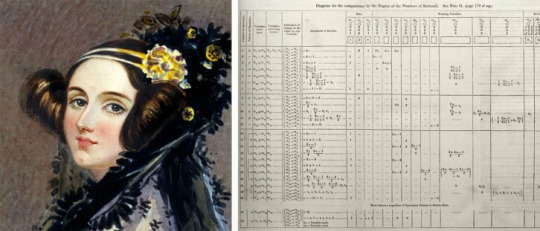
She has since been celebrated by giants such as google, and she has given name to a programming language (Ada). She was also the first person to write about what is today known as AI. Back when she was practicing, computers were simply thought of as calculators. But she had an idea that if computers can understand numbers, then that can be translated to letters, and in turn that can lead to computers being able to handle words, and eventually even write, draw and create music.
Hedy Lamarr was a famous Hollywood actress in the 40's, but she was also an inventor who laid ground for what we use today for Wi-Fi, Bluetooth and GPS services.

During WW2 she wanted to contribute positviely to the military efforts against the Nazis, and she tried to figure out how to radio control torpedoes. In 1942 she patented her technology "Secret Communications System", also known as frequency hopping, which laid the foundation for the technology we use today for Wi-Fi, GPS and Bluetooth. It wasn't until 1962 that it was first used for its intended purpose, during the cuban missile crisis.
Grace Hopper invented the first compiler, called A-0, in 1955, and was also part of the Univac team, which was the company also responsible for building ENIAC. She also initiated work on the COBOL programming language.

She was also the one to coin the term "bug" in 1947. Computers back then had lights to visualize their working process (which was also a womans idea to implement btw) and bugs would be attracted to the lights, but usually that was no issue - until a bug made its way into a tube which caused the computer to stop working. Hopper taped the bug to a piece of paper and logged what caused the crash - a bug.
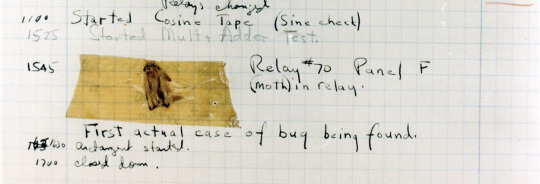
Dorothy Vaughan (left), alongside colleagues such as Katherine Johnson (middle) and Mary Jackson (right), was a mathematician at NASA (called NACA when she started) who worked on the orbit for the first ever manned spaceflight and later also on Apollo 11 that would take humanity to the moon!
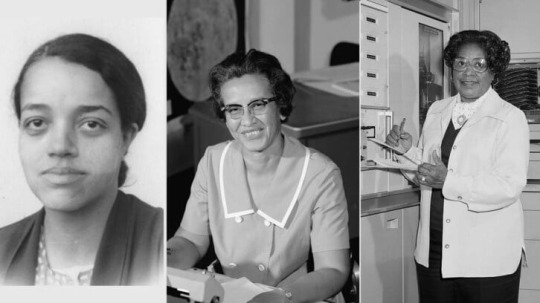
When Vaughan started at what was then called NACA, segregation was still prevalent in the US and she was not allowed in the same areas in the office as her white colleagues. Another department was formed for the black staff, and when the director of said department unexpectedly died, she was appointed as the new director and thus became the first ever black woman at that position at NACA/NASA. In 1958 when NACA becomes NASA segregation is forbidden, and that is when Vaughan and her colleagues Johnson and Jackson started working on programming the orbit and later also Apollo 11.
Continuing on the same track of NASA and space, Margaret Hamilton was the Apollo project's first actual programmer. Hamilton became the director of software engineering at NASA in 1965, and she was also the person to first coin the term !

In the image above, she stands next to all the handwritten code that was used to send humanity to the moon. During the early stages of the project when she would speak of "sofware engineering", software development was not taken as seriously as other forms of engineering, and it wasn't regarded as a science, either. She wanted to legitimize software development as an engineering discipline, and overtime the term "software engineering" gained the same respect as any other technical discipline.
And lastly, if you're a woman in STEM, I want to highlight and celebrate you! Being a woman in a male dominated industry is not easy, we often suffer from sterotype threat and are not seen as our own individuals, but rather "the woman" in a room full of men. But just as these women, I'm sure you will achieve greatness!!
Here are some additional resources if you'd like to learn more:
https://www.history.com/news/coding-used-to-be-a-womans-job-so-it-was-paid-less-and-undervalued
https://digitalfuturesociety.com/programming-when-did-womens-work-become-a-mans-world/
And this was mainly my source for this post, but it's unfortunately only available in Swedish:
Thank you for reading ✨
#womens day#women in stem#woman in stem#woman in tech#girl coder#girl programmer#programming#programmer#software#software development#software developer#software engineering#javascript#python#css#html#react.js#django#php#mysql#sql#database#frontend developer#frontend development#webdev#web development#backend development#history#women in tech#women in history
956 notes
·
View notes
Text
The Most Common Types of Fairy Godmother in "Cinderella" Adaptations
Since @ariel-seagull-wings and I have already posted about the different portrayals of Cinderella and her prince, I thought it might be nice to look at the different portrayals of the other characters too.
Each portrayal of the Fairy Godmother is unique, but patterns do emerge across the different adaptations. I've found that the different portrayals of the character can be divided into five categories, with some portrayals combining two of them together.
The Regal, Ethereal Lady

This beautiful, elegant creature is emphatically a fairy godmother, not a godmother who happens to be a fairy. She wears a gorgeous flowing gown, not of any earthly fashion, and though her age is indeterminate, she seems youthful yet wise. Her demeanor is kind and gentle, yet serious and stately, though she might have a slight playful streak. She takes on the role of the story’s moral authority as well, usually emphasizing that she comes to reward Cinderella for her goodness. Often, she first appears disguised as an old beggar woman to test the respective virtue of Cinderella and her stepfamily, and Cinderella earns her good will by giving her bread while the stepfamily scorns her. Sometimes she has attendant fairies or other magic-users to assist her as well: she might even be portrayed as the Fairy Queen, who lives in the forest like Shakespeare’s Titania and has countless fairies, elves, and sprites as her command. Fairy Godmothers of this type are most often seen in earlier adaptations: they include “La Fée” in Massenet’s opera Cendrillon, the Fairy Godmother in Prokofiev’s ballet, Inez Marcel in the 1914 silent film, Varvara Myasnikova in the 1947 Russian film, Celeste Holm in the 1965 version of Rodgers and Hammerstein’s musical, and the animated Fairy Godmothers both in the 1935 Betty Boop cartoon Poor Cinderella and in the 1979 Russian animated short.
The Grandmother Figure

This Fairy Godmother is a little old woman, and she’s very human as fairies go. She might not be regal, or beautiful, but she radiates a sense of warmth and comfort like all the best grandmothers do. Her sweetness, gentleness, and maternal affection are just what Cinderella needs in her despair, and sometimes she can be adorably absentminded – forgetting where she put her wand, almost sending Cinderella off to the ball in her rags, etc. – which adds gentle comic relief to the story. Yet she also conveys the wisdom that comes with age, and her magic is just as powerful as that of any younger, more glittering fairy. The quintessential Fairy Godmother of this type is the one voiced by Verna Felton in Disney’s classic 1950 animated film. Several other animated versions aimed at children feature grandmotherly Godmothers too, like the versions from Jetlag Productions and Burbank Animation Studios. In the 1995 musical A Tale of Cinderella, “La Stella” is Cinderella’s actual grandmother, whose magic sadly couldn’t save her daughter’s life, but can save her granddaughter’s future. Jean Stapleton’s Fairy Godmother in the 1985 Faerie Tale Theatre adaptation is also very grandmotherly, although she has additional glamour and a sense of humor that bring her closer to the next type of Fairy Godmother on the list (see below).
The Sassy Glamour Queen

She’s beautiful, she’s elegant, she’s as smart as a whip, and she knows it! This is a more modern, lighthearted twist on the Regal, Ethereal Lady. The sparkle of the gorgeous gown she wears is matched only by the sparkle of her playful wit, and her confidence in herself is surpassed only by her confidence in Cinderella. Her sense of humor lifts Cinderella’s spirit, while her intelligence, poise, and indefatigable spirit make her a strong role model for the girl. Yet though kind and caring, this Godmother tends to be a bit more standoffish than others – though not in a bad way. She urges Cinderella to solve her own problems, not just rely on her, and to have courage and faith in herself against all odds. The most famous Godmother of this type is probably Whitney Houston in the 1997 version of Rodgers and Hammerstein’s musical. But Edie Adams’ elegant and mischievous Godmother in the original 1957 Rodgers and Hammerstein telecast is a good example too: although since she spends most of the story masquerading as a human, she combines this portrayal with another type (see the bottom of the list). Meanwhile, Jean Stapleton’s Faerie Tale Theatre Godmother has the elegance and humor of this type, but as an elderly woman, she combines it with the Grandmother Figure. Last, but not least, is Billy Porter’s nonbinary “Fab G.” in the 2021 Sony/Amazon musical.
The Eccentric Mage

This funny and kooky Godmother is one of those beings who combine magic with just a little insanity. Her mind is like her powers: not entirely of this earth. Like the Regal, Ethereal Lady, she tends to disguise herself as a poor, ragged old woman to test Cinderella’s virtue and befriend her before the ball – but she takes it a step further and masquerades as a crazy homeless woman, who spouts odd remarks and whom anyone less kind than Cinderella might try to avoid. Yet even when not in disguise, she’s a bit of a ditzy oddball, who sometimes fumbles her spells once or twice before she gets them right: e.g. dressing Cinderella in the wrong type of clothing at first, or turning the pumpkin into the wrong item, or accidentally making it grow to a gigantic, greenhouse-shattering size before it becomes a coach. Fairy Godmothers of this type include Helena Bonham Carter in Disney’s 2015 live action film, “Crazy Marie” in the 2013 Broadway version of Rodgers and Hammerstein’s musical, Joyce Gordon in the Muppets’ Hey, Cinderella! and Estelle Winwood as Mrs. Toquet in The Glass Slipper. Although since Mrs. Toquet never takes off her “crazy poor woman” disguise, she combines this variant with another one: The Godmother Who Happens to Be a Fairy (see below).
The Godmother Who Happens to Be a Fairy

This is the most human portrayal of the Fairy Godmother: an ordinary woman who just happens to have magical powers, which she hides until they’re needed. Cinderella typically befriends her long before the ball, sometimes knowing her from childhood. She might be a household servant, or a kindly neighbor, or a traveling portrait painter, but whoever she is, you wouldn’t guess that she’s a fairy. She might even pretend not to believe in magic. She might also be Cinderella’s literal godmother – a close friend of her late mother’s, or even a relative. But no matter who she is, the friendship and the simple, human advice she gives to Cinderella (e.g. never to lose hope, or not to be afraid to love the Prince) are just as valuable as her spells. Edie Adams’ mischievous Godmother combines this characterization with the Sassy Glamour Queen in the 1957 Rodgers and Hammerstein musical, Estelle Winwood’s Mrs. Toquet in The Glass Slipper combines it with the Eccentric Mage, and Annette Crosbie’s sensible and ladylike yet quirky Godmother in The Slipper and the Rose combines it slightly with the Eccentric Mage too. Other examples are the artist Paulette in the anime series Cinderella Monogatari, the cook Mandy in the original novel of Ella Enchanted (who is also the Grandmother Figure), and the pasta-stirring grandmother La Stella in the musical A Tale of Cinderella (ditto).
@ariel-seagull-wings, @thealmightyemprex, @adarkrainbow, @themousefromfantasyland, @faintingheroine, @angelixgutz, @softlytowardthesun, @amalthea9
#cinderella#fairy tale#fairy godmother#adaptations#characterization#comparison#character types#patterns#fictional characters
69 notes
·
View notes
Text
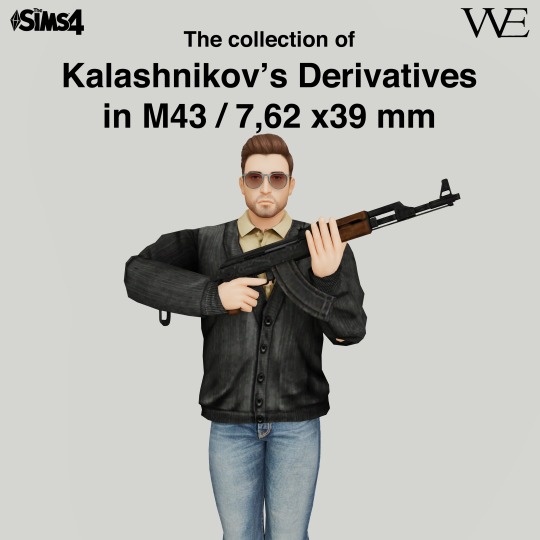
Avtomat Kalashnikova's Rifle Series
Part 1: 7,62 x39 (Soviet M43)
DOWNLOAD🔽
Information
Right after World War II ended, the Red Army began searching for a new service rifle. They sought a rifle that would fire a cartridge based on the M43—a shortened version of the 7.62 x 54mm round, which became the 7.62 x 39mm. This new round was chosen for its moderate recoil and suitability for automatic fire. Initially, the semi-automatic Simonov SKS was selected as an interim solution while the search continued.
In 1946, Mikhail Kalashnikov entered his design into a competition alongside others. However, the Central Committee was not satisfied with the initial results, and all contestants were required to make improvements. A year later, Kalashnikov returned with a modified version, which he named the "Avtomat Kalashnikova model 47." Tests showed that Kalashnikov's design met all the Central Committee's requirements. Ultimately, his design was standardized as the Red Army's main service rifle, simply named the "AK" or "Avtomat Kalashnikov."
🇷🇺Original Releases🇷🇺
The rifle that started it all—the AK-47—is Mother Russia’s proudest gift to the world, born from the genius of Mikhail Kalashnikov. This section details the original AK model produced by the Soviet Union and it's Successcor States, Russian Federation, mark the beginning of an iconic rifle series
AK-47 (Avtomat Kalashnikova 1947)

Of all the weapons in the vast Soviet arsenal, nothing was more The One that Started all. nothing is more profitable than Avtomat Kalashnikova model of 1947, more commonly known as the AK-47, or Kalashnikov. It's the world's most popular assault rifle. A weapon all fighters love. An elegantly simple 9 pound amalgamation of forged steel and plywood. It doesn't break, jam, or overheat. It will shoot whether it's covered in mud or filled with sand. It's so easy, even a child can use it; and they do. The Soviets put the gun on a coin. Mozambique put it on their flag. Since the end of the Cold War, the Kalashnikov has become the Russian people's greatest export. After that comes vodka, caviar, and suicidal novelists. One thing is for sure, no one was lining up to buy their cars.
This Particular Model is first adoption of the AK family by the Red Army in 1949 & Contray to Popular Believe This Type Of Rifle Along With It's Folded Stock Variant Are So Rare and inteded as Red Army Trial Model. It got short service lenght in the Advent Of AKM.
AKS-47 (Avtomat Kalashnikova Skladnoy Model 1947)


Later versions of the original AK-47 are basically standard AK-47s but with a downward-folding metal stock (like the one on the German MP40 submachine gun). This design makes it easier to use in cramped spaces, like inside BMP infantry combat vehicles, and for paratroopers use. It was adopted for use by the Soviet military.
AKM (Avtomat Kalashnikova modernizirovanny)


The AKM is a improved & modernized variant of the AK-47 and was produced in much larger numbers. The most notable difference is that the AKM has a stamped receiver, making it lighter and less costly to produce, a slant compensator on the tip of the barrel (to reduce recoil) & an improved gas tube to ensuring Reliability. The Most Obiquotous AK Variant In Market.
AKMS (S – Skladnoy – Folding), A Variant Of AKMS which was equipped with an under-folding metal shoulder stock. The metal stock of the AKMS is somewhat different from the folding stock of the previous AKS-47 model as it has a modified locking mechanism, which locks both support arms of the AKMS stock instead of just one (left arm) as in the AKS-47 folding model. Like The perk From it's Main Rifle. This Variant Also Featuring More Lighter, Cheaper to Produce and better Recoil Management
AK-103/ Kastov 762

Note:Some of You young folks might knowed this gun from New Call of Duty LOL
The Trend of Weapon Modernization of 21st Century Finally Fall into Kalashnikov's Ear And AK 103 is the Answer for that. The AK-103 is a newer version of the AK-47. It still uses the same 7.62×39mm ammo but comes with some upgrades like a more comfortable synthetic stock and better materials like it's 5.45 Version brother. It’s designed to be more accurate and reliable, making it a solid choice for military and law enforcement use. Overall, it’s a tough like What you expect from Kalashnikov Rifle, modern rifle that handles well in different situations.
AK-104

A Russian Modern Answer to M4 Carbine. The AK-104 is a modernized version of the AK-47, designed to compete with the American M4. Chambered in 7.62×39mm, it’s more compact and features a folding stock, making it easier to handle in tight spaces. The AK-104 incorporates updated materials and design elements to stay relevant in today's weapon trends. Kalashnikov's ability to adapt and innovate has kept the AK series influential and trendy, maintaining its status as a leading choice in firearms across the globe.
☭Warsaw Pacts Derivatives & Foreign Copies☭
Due to the popularity of the Kalashnikov rifle and the heightened Cold War marked by the foundation of the Warsaw Pact (Soviet's defense pact to match Western NATO), many communist-aligned nations started copied Kalashnikov designs, both legally and illegally. The following section covers the foreign derivatives of the legendary Kalashnikov!
🇭🇺FEG AMD-65 (Automata Módosított Deszantfegyver 1965)🇭🇺

Another Masterpiece from Hungarian Factory Fegyver- és Gépgyártó Részvénytársaság. Popular Amongst Afghanistan National Army (Afghan's Army during occupation of United states of America, Until the fall of Afghanistan in 2021) is a modified compact version of the AKM-63 made for use by specialist troops like paratroopers and vehicle crews. The AMD-65 featured a shorter barrel, a muzzle brake, and an Iconic side folding stock.
The AMD-65 is the most famous variant of the Hungarian AKs, due to its distinctive appearance and more widespread availability in the United States compared to other variants.
🇵🇱FB RADOM Wz. 96 Beryl M762🇵🇱

representing Poland's efforts to develop modernized indigenous 5.45x39mm and 5.56x45mm Kalashnikov Rifle in response to late Cold War Warsaw Pact and NATO cartridge standardizations. This particular Model is is an export version of the kbs Wz. 96C chambered in 7.62x39mm. It is most notably used by Nigeria. and Mostly Popular Amongst "PlayerUnknown's Battlegrounds" Gamers or PUBG.
🇷🇴Pistol Mitralieră model 1963/1965🇷🇴


PM md. 63 (Romanian: Pistol Mitralieră model 1963; lit. "model 1963 submachine gun") is the Romanian military designation of Romanian manufactured clones of the Soviet AKM. Produced at the Cugir Arms Factory (today a subsidiary of ROMARM), early Romanian Kalashnikov rifles were almost indistinguishable from Soviet AKMs, but a number of Romanian domestic features were introduced in later production models, making them more and more distinct from Soviet Kalashnikovs. it is better known under the export name of AIM.
PM md. 65 The PM md. 65 is the Romanian clone of the AKMS. As with the md. 63, the rifle features a foregrip integrated into the handguard; in order to accommodate the underfolding stock, however, the foregrip of the PM md. 65 notably slants backwards. The rifle is exported to the west under the export name AIMS.
The Mini Draco (imported by Century Arms) is an ultra-short export variant of the Romanian AK featuring a 7.75" barrel. intended For US Civilians. Straight From Grand Theft Auto V
🇫🇮SAKO/Valmet Assault Rifle Series🇫🇮


The Finnish firearms manufacturer Valmet built assault rifles, in co-operation with Sako, based in part on the Kalashnikov action in the early 1960s, and continued to manufacture them up until 1994. Valmet later merged into Sako (in the late 1980s), and the some of their designs are currently being manufactured.
The model M62 (known as Rk 62 in Finland) was adopted by the Finnish Defence Forces, and still serves as the standard infantry weapon of the Finnish Army.The M62 has an unusual T-shaped tubular buttstock, compared to other Kalashinkov pattern rifles. The gas block and front sight design is very similar to the Israeli Galil rifle, as the Galil was designed based on the Valmet.
The RK 95 TP (known commercially as M95) is an upgraded variant of the M62, designed and manufactured by Sako. It has a folding stock, and can be fitted with suppressors. It was adopted into service by the Finnish Army, although in relatively small numbers, and it is still used by Finnish Special Forces. An export variant in 5.56mm was also produced in extremely limited numbers.
🇨🇳Norinco Type 56🇨🇳




The Type 56 assault rifle is the Chinese clone of the Soviet AK-47 rifle. It was China's service rifle from 1956 to the adoption of the QBZ-95 in around 1997. The Type 56 is the most commonly used AK variant in American film and television productions. This came about because China exported civilian AK variants (both Type 56 patterened and less commonly Soviet AK patterened) to the West in large numbers during the 1980s, primarily by the export companies Norinco
QBZ-56C (Type 56C) – Short-barrel version, introduced in 1991 for the domestic and export market. The QBZ-56C as it is officially designated in China, is a carbine variant of the Type 56-2 and supplied in limited quantities to some PLA units. The Chinese Navy is now the most prominent user. The QBZ-56C is often carried with a twenty-round box magazine, although it is capable of accepting a standard Type 56 thirty-round magazine. It also has a sidefolding stock in addition to a muzzle booster, giving it a similar appearance to the AKS-74U.
Type 56-2 – Improved variant introduced in 1980, with a side-folding stock and dark orange bakelite furniture. The stock also houses a cleaning kit, which both underfolding AKs (all nations) and other sidefolding AKs lacked, instead requiring a separate pouch. It also allows a traditional detachable bayonet, both AK-47 and AKM styles, as an option in addition to the folding spike style. Mainly manufactured for export and rare in China.
Type 56-2M - Basically Norinco Type 56-2 fitted with an aftermarket LHV-47 handguard and ergonomic pistol grip. Perfect for Customization. Model Straight From Grand Theft Auto V
💀Special Role And Novelty Items🤡
This Section will Covering Some Specialized Roles of Kalashnikov Rifle And some just a novelty Items of it which is specifically designed to serve no practical purpose, and is sold for its uniqueness
RPK-47

The Light Machine Gun Version of Legendary Kalashnikov's Assault Rifle. Featuring A Heavier Barrel for supporting Sustained fire, Bipod To enhance stability and accuracy during sustained fire, the RPK includes a bipod. This feature allows the operator to stabilize the weapon while firing from a prone or kneeling position, which is crucial for maintaining accuracy and control in a support role. along with the RPK often features a sturdier stock, which helps manage recoil and enhance overall stability while firing. this particular Version is Using 7.62X39mm
Golden AK Series


Note:Special Thanks For @bluexxxxx For magnificent Watergun Pose in Second Picture.
Alright, picture this: the iconic AK-47, but with a dazzling twist. That’s the Golden AK Series for you! Imagine the legendary Kalashnikov rifle decked out in a sleek, gold finish that screams both style and power. These rifles aren’t just about looking cool (though, let’s be honest, they definitely do). They’re also built with all the rugged reliability and firepower you expect from an The Cold War champion. So, if you want a rifle that combines legendary performance with a touch of glamour, the Golden AK Series is where it’s at. It’s not just a tool; it’s a statement.
@exzentra @exzentra-reblog
#the sims 4#the sims 4 custom content#ts4#ts4 cc#ts4 gun#ts4 military#call of duty modern warfare 2#cod mw2#pubg#pubg: battlegrounds#the sims 4 cc#the sims 4 gun#the sims 4 military#warsaw pact#soviet union#russia#ak 47 gun#ak 47 rifle#kalashnikov#romania#hungary#finland
30 notes
·
View notes
Text

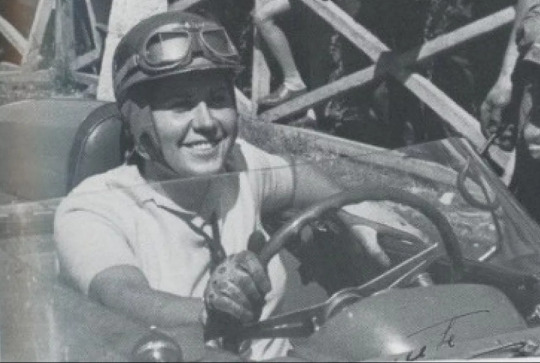

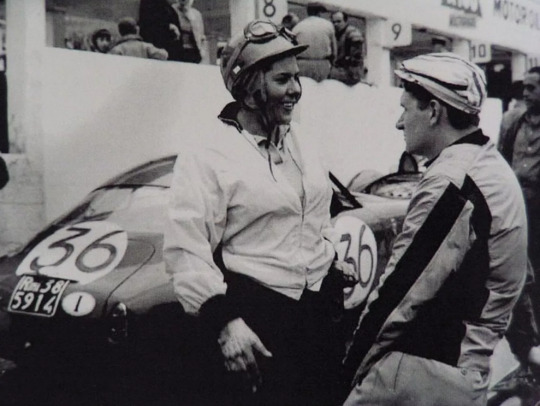
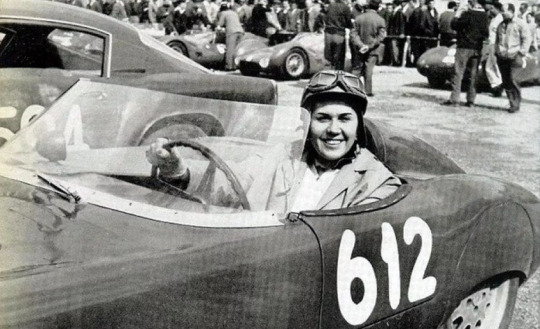
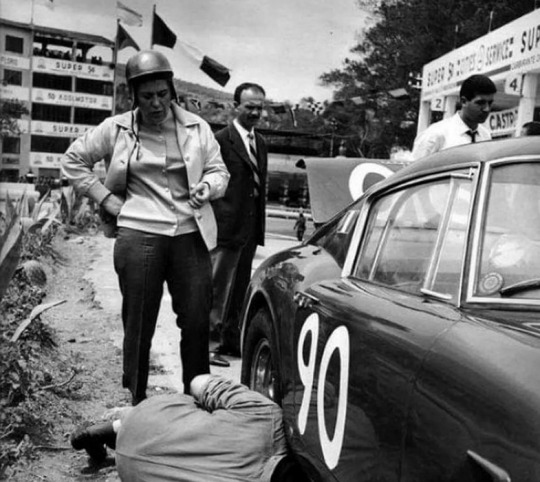
Ada Pace (1924-2016) aka "Sayonara"
Ada started her career as a motorcycle racer, competing since 1947 in several races and having quite a success. She started racing cars in 1950 and achieved her fist victory the next year, much to the embarrassment of the organizers of the race, who had no protocol on how to award a victory to a woman, yet alone an umarried one. She drove to the podium with her mother sitting next to her, keeping an eye on her daughter in that all-male world. Ada kept on collecting victories, much to the chagrin of her male colleagues, who kept protesting and in one case even refused to be on the podium next to her, because they couldn't fathom standing on a lower step than a woman. On an occasion, other drivers complained that her car was irregular, so the organizer had not only her car, but also the complainers' cars, tested. Ada's car was fine, but the complainers ended up being disqualified... She gained the appreciation of personalities like Enzo Ferrari, the Maserati brothers and Cesare Fiorio, and for all the drivers who were upset about being overtaken by a woman during a race, she had her message: the plate on the back of her car simply read "sayonara", her way to say "let's see you on the finish line".
#ada pace#women in motorsports#i didn't know anything about her until today! i can't believe it#women in motorsport#she deserves to be known more#my posts
69 notes
·
View notes
Text

Strength test of the new bridge 30.10.2024
475.111 "Pětasedma" or "Šlechtična" since 1947
#steam train#steam locomotive#steam locomotives#steam engine#locomotive#locomotives#trains#train#railways#photographers on tumblr#czech republic#czechia#prague#adventure#explore#photography#photooftheday#picoftheday#europe#history#town#city#steam trains#railroad
15 notes
·
View notes
Text

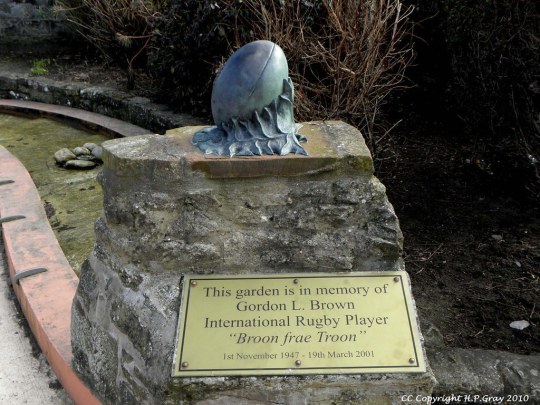
The rugby player and commentator Gordon Lamont Brown was born on the 1st November 1947.
Known quite simply as Broon fae Troon, Brown was from a sporting family, his elder brother Peter also played for and captained the Scottish side. His father, John played goalkeeper for the Scottish football side and also appeared in the Scottish Open at Royal Troon alongside golfing greats such as Arnold Palmer. He is also the nephew of footballers Tom and Jim Brown.
Broon was a legendary Scotland second row and a fully-paid up component of the Mean Machine; a triple Lion and fierce competitor in the Battle of Boet Erasmus; a ruthless assassin on the pitch and a true gentleman off the field of play.
early interest was in the round rather than the oval ball. His conversion was reportedly the result of a particularly heated football tie, after which he reckoned ‘rugby would be safer’! He emerged on to the international stage in December 1969, from West of Scotland, having just turned 22.
After a winning debut against South Africa, he retained his place for the Five Nations opener against France. Dropped for the subsequent Wales match, he was replaced by brother Peter who revelled in breaking the news to Gordon. Peter was then injured in the match – and replaced at half-time by his younger sibling; the first occasion where a brother had replaced a brother in an international. When the Browns joined forces against England in 1970, it was the first time brothers had played together for Scotland since Angus and Donald Cameron in 1902.
Immovable in the scrum yet dynamic in the loose, Gordon went onto cement his place in Scotland’s front five of the early 1970s, the formidable Mean Machine that also featured Ian McLauchlan, Frank Laidlaw, Sandy Carmichael and Alastair McHarg. Between 1971 and 1976, Scotland lost just once at home, a narrow defeat to the All Blacks.
A giant of a man, both physically and figuratively, he formed a key partnership in the blue jersey with McHarg, winning 30 caps; in a Lions shirt, he was one of the world’s most ruthless competitors. Not only could he move but his outstanding handling skills resulted in eight tries on the Lions’ 1974 venture – including the brutal Battle of Boet Erasmus – a record for a forward. He played in eight Lions’ Tests between 1971 and 1977, playing a major part in the 1971 and 1974 victories. A string of injuries ended his career, but not before an infamous incident in a match between Glasgow and the North-Midlands, he was suspended for three months after getting into a fight with Allan Hardie, in which Brown chased Hardie, threw him to the ground and kicked him. Prior to this, Hardie had kneed Brown in the face and proceed to stamp on the open wound on Brown's brow after the initial attack went unnoticed by the referee. The suspension meant that he missed three internationals and was banned from training at any rugby club.
The hardest battle came two decades later, with the diagnosis of non- Hodgkin’s lymphoma. A battler to the end, he died in 2001, aged just 53.
7 notes
·
View notes
Note
You really support israhell? After everything they have done? The 75 years of brutal and inhumane colonization and oppression, the torture, the rape, the theft, the burning of hundreds of years old indigenous olive trees, everything? Don't you even see that they did to Palestinians exactly what Americans did to the natives? This is honestly really disappointing. I hope you at least just remember that Palestine was given by one white racist man to another white racist man to get rid of the "jewi
You really want to go there? Okay, lets go there! To use your own logic, the native American analogy you’re so found of also applies to the Jews in Israel. Romans tried to expel all Jews and then rename the territory "Palestina" after the Philistines (enemy of the Jews), and Jerusalem "Aelia Capitolina" (after Hadrian and Jupiter) to erase the Jewish connection. Except that did not work because some Jews remained and then others came back. And they never stopped returning: from immigration in 200-500 AD, the eleventh century, until the movements in 1882, early 1900s, right up to 1948.
I'm sure you know the Ottoman Empire happened until it didn’t, and the territory switched to Britain who called the territory Mandatory Palestine, so the “Palestinians are those who live there, meaning Arabs AND Jews. This is inconvenient historical facts for you, Jews were living there already!
Do you think the Ottomans would have tolerated state-building by Jews? Neither the Ottomans nor the British would ever have tolerated an illegal or violent state-building attempt by Jews. That is why until 1948, the future state of İsrael consisted of territory bought by the Jewish National Fund and empty lands accorded to the Jewish state under the UN partition plan.
Then the Arab world declared war in 1947 and got their asses roundly kicked by the Jews and end up occupying a number of territories originally intended to be part of the abortive Arab state of Transjordan. The furious butthurt Arab nations expelled 900,000 of their own Jewish citizens (those they didn’t kill) so the refugees made their way to Israel in 1948. Judea and Samaria (aka the West bank) belong to Jordan, Gaza to the Egyptians, Golan Heights to Syria. Green line established as an armistice line.
The Arab world declared war again in 1967 and got their asses round kicked by the Jews. Just before the war, Arabs left the area and figured they can come back after all the Jews are killed and take everything the Jews owned or had build, the farmlands they built out of swamps and desert…. Except that didn’t happen and they became sore losers.
Jordan gave up their claim to Judea and Samaria in the 1990’s and Sinai was given back to Egypt, Israel immediately started negotiating with the PLO for peace. Oslo granted the Palestinians the first land that they could claim was theirs and no one else’s. Israel then moved on to direct negotiations with Arafat to give them a proper state with legal borders in exchange for peace. Arafat rejected it and launched the Intifada. Israel tried again when Abbas took over, but he refused to even talk. In an attempt to buy peace, and as a test of the Palestinian’s intentions, Israel completely pulled out of Gaza, hoping that it could become something like Singapore or Monaco. Instead, Hamas took over, destroying the infrastructure that Israel left behind and launching terrorist attacks against Israel ever since.
Hamas could have rebuilt hospitals and schools with the millions of dollars given in previous conflicts in Gaza. They could have built bomb shelters for their citizens. But no, they built underground tunnels and bunkers, designed to breach Israel's boarders and protect their own. You cannot have peace with Gazans whose sole aim is to kill you and rape the women and then kill them.
Then October 7 happened. Hamas gleefully opened fire on babies, children, families in their beds. They stabbed children kept the knives in them before killing their parents. They didn’t spare family dogs. They gang-raped women and paraded their dead bodies in the streets. Hamas exceeded the Nazis in brutality. Any collateral damage to the innocent is unintentional on Israel's part as opposed to Hamas who surround their own soldiers with children. Hamas is literally using their own children as meat shields.
Gaza started a war. They are getting what they wanted. Why are you complaining?
Did you protest in 2006 when Gaza elected Hamas?
Did you protest in 2007 when Hamas declared war on Israel and said it would eagerly murder Israelies - which is what caused the Israeli blockade and later the Egyptian blockade.
I bet my two houses you didn’t protest for the past sixteen years while Hanas fired at Israeli civilians, sometimes causing Israel to fire back.
You weren’t at all bothered that for 16 years the Hamas used their own citizens human meat shields and build military infrastructure beneath hospitals and schools
Meanwhile, 21 Arab countries would rather let Gazans die than admit them as refugees. Where are your complaints about that?
In conclusion: Unlike all the countries in the Americas and Australasia, and many elsewhere, Israel actually is NOT on occupied land, illegal or otherwise. The fledgling state of Israel bought land fair and square from Ottoman landlords and was granted statehood by the UN. Now, you could argue whether the Ottomans should have been able to sell that land, as they were absentee landords – but they did have legal titles to it and they legally sold the land to the Jews. So Israel has much greater legitimacy than the U.S, Argentina, Australia, or New Zealand. Go bitch about them, you cowardly hiding-behind-greyface-Anon.
Btw, I'm always hugely happy to disappoint pro-rapey-terrorists people like yourself.
33 notes
·
View notes
Note
You said your asks were open if they still are New Mexico headcanons please lol
This is in no way forcing you to do it if you can’t so please don’t feel forced or rushed!
YEEES!!! yea of course!! i adore NM i think about him sm... i dunno if i have many hcs, but i will share mine ^_^
New Mexico HCs!
He's only of the only states that can genuinely handle spice. The vast majority of the statehouse is absolutely awful at handling spice, but New Mexico can just..eat raw peppers with no reaction.
He absolutely hates when the theater loving states sing Santa Fe from Newsies. It makes him want to start swinging. When New York sings it? God he's plugging his ears, and grabbing a bat to smack him.
Smokey The Bear is actually from New Mexico! So I think this guy has Smoke The Bear merch for DAYS! He's a huge fan dude. Only you can prevent forest fires .
He's one of the youngest states! Seeing as New Mexico is one of the "newest" states, he's super young.
It surprises a lot of people, but New Mexico is actually extremely artistic! He's constantly found painting and sketching. He typically paints / draws landscapes and flowers. He absolutely adores how nature looks, and wants to preserve it in paper.
He switches between English and Spanish often. It's a bilingual struggle. Often when he's upset, he'll begin shouting in English, and then it turns into a jumbled mix of Spanish and English.
He believes in UFOs, and aliens! A UFO crashed in Roswell in 1947, and he's been extremely passionate about it ever since! He talks about it all the time.
He's got a large scar on his back, a circular explosion scar! This is from when the first atomic bomb was created, and then detonated as a test in New Mexico.
He has a love / hate relationship with Breaking Bad. He absolutely hates that it's currently what he's known for. Every time that he hears where Walter White lives he goes fucking insane. Oh that boy just goes crazy.
#wttt#wttsh#wttt new mexico#wttsh new mexico#new mexico wttt#new mexico wttsh#welcome to the state house new mexico#new mexico welcome to the state house#welcome to the table new mexico#new mexico welcome to the table#welcome to the table#welcome to the state house#wttt hcs#wttsh hcs#welcome to the state house headcanons#welcome to the table headcanons#welcome to the state house hcs#welcome to the table hcs#new mexico wttt hcs#new mexico wttsh hcs#wttt new mexico hcs#wttsh new mexico hcs
12 notes
·
View notes
Text
I was dusting the house as normal, like I did every week when I saw a strange golden card note on the kitchen table labelled “for my first ancilla”
“Strange” I thought, Mistress Luci was not normally like this, sure she was affectionate at times, but that’s normal for humans to feel that way about their pets. Curious, I opened it, it said: “3pm, on the private beach, near the cove, dress your best”
The time came and I walked down the garden and down the cobbled steps onto the beach. I was dressed in Merrel sandals instead of the standard Imperial Serva heeled sandals, a pink and white pleated skirt given as a gift for good behaviour instead of my summer cherry skirt or my standard issue skirt , a Very Special Occasion (MEO-Mucha Especial Ocasión) scented wick away slave blouse instead of the standard version, and a Peugeot love heart shaped chain link Titanium alloy collar instead of the standard oval chain link medicollar
Mistress looked at me up and down like five times before saying a word. “You’re… beautiful” she finally said, clearly rendered speechless. I curtsy in front of her, “thank you Domina” i replied, remembering to use Latin as well as my native British “where are we going” she had no obligation to reply and so kept silent as we walked to the cove admiring the waves and the cool afternoon, until I could see it, her Amphibicar Fiat Chariot (think like an Italian Ford Crown Victoria or Opel Omega), those things had been around 2610 AUC (1867), but this was a 22nd generation rear mid engined 2766 (2012) Amphibian vehicle variant (itself in it’s 10th generation since 2680 (1947)) with a 5.5L Ferrari Turbo V8, modular and hydraulically adjustable bench seats front and rear, four wheel drive courtesy of Lancia and a luxurious 3-speed hydraulic automatic transmission (with three electro-locked overdrive gears tacked on in the 2760 refresh for fuel and performance, as well as to hide its age) yanked out of the Buick Sappho coupe “Mistress this is wonderful” I turned to see her and say thank you, but found her on one knee
“Julia, I have legally submitted a form for us to be married, so that you won’t have to worry about losing me, your first constant and comfort in a long time” she pulled out a finger print scanner, “all I need is your fingerprint”, I pressed down excitedly, then my tabula got a notification
“Married to Doctor Luciana Antonia Presenti MD, PhD”
And another, from Fiat Intelligencia Automobilli “Authorised Guest of Luciana Presenti’s Intelligent Control System on her 2766 Fiat Chariot”
Mistress added on, “use it wisely”
I oblige “Fiat, open doors-“
Mistress chides playfully “No slave, stupid slut, type it out in the app”
I open the app and find the command room, where I find Mistress had already done test runs, I type in, “open driver door and say “welcome Domina””. It does so flawlessly and without hesitation. Mistress blushed “thanks pet, really appreciate it” she found the 2730s Buick touchscreen still in there with updated visuals and apps, but the same size of the screen and the same working concept. She typed in, “open passenger left back door and give the back ambient red gel lights and put on brothel music”. It did so. “very funny mistress”
(Another case of part two when I feel like it)
#mtf sub#nblw nsft#nb sub#wlw nsft#sapphic nsft#cnc kink#lesbian slave kink#dubious consent#slight bit of a nerdy car ramble about an alternate universe#2770 ab urbe conduita#bd/sm pet#bd/sm slave#bd/sm blog#bd/sm kink#bd/sm smut#bd/sm story#slave and mistress
9 notes
·
View notes
Text
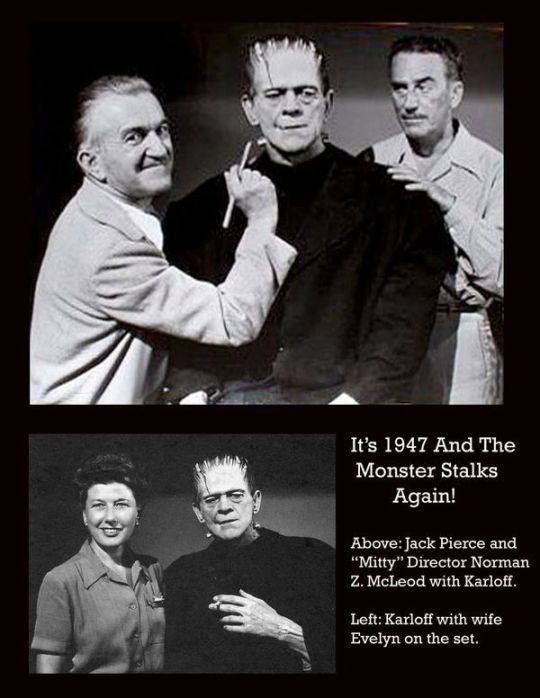
What coulda - and shoulda - been dept.:
Make-up legend Jack Pierce got to transform actor Boris Karloff one final time as the Frankenstein monster for Danny Kaye film The Secret Life of Walter Mitty (1947). Karloff had not played the monster since 1939's Son of Frankenstein. Pierce, Karloff, and the monster's make-up design were loaned by Universal Pictures to Mitty producer Samuel Goldwyn for use in a dream sequence in the film.
Unfortunately, the dream sequence was cut from the film. I haven't been able to find any definitive answer as to whether it was ever actually shot. All anyone seems to have are these make-up/costume test photos shown above.
#Jack Pierce#Boris Karloff#Frankenstein's monster#Norman Z. McLeod#Evelyn Karloff#The Secret Life of Walter Mitty
34 notes
·
View notes
Text
In November 1988, the Palestine Liberation Organization (PLO) met in Algiers and issued a Declaration of Independence, proclaiming the state of Palestine. The declaration grounded the new state in the 1947 U.N. Partition Resolution, which called for two states, one Arab and one Jewish. The PLO’s goal, as with Hamas today, had previously been the “liberation” of all of Palestine, from the river to the sea. In the 1988 declaration, the PLO reversed that position. Four weeks later, the PLO recognized Israel’s right to exist.
Immediately following the proclamation, Algeria, the host country, announced its recognition of the state of Palestine. And almost immediately, the United States launched a worldwide effort to persuade other countries to withhold recognition and thwart the Palestinians in their campaign to gain admission into international organizations.
Today, 139 countries recognize the state of Palestine, but this does not include the major Western democracies. The state is a member of many international organizations but not the United Nations, where the United States, through the Security Council, has blocked admission. Yet since 2012, Palestine has been recognized by the United Nations as a non-member observer state.
Now, triggered by the war in Gaza, this may change. British Foreign Secretary David Cameron, has stated that the United Kingdom is considering recognizing Palestine and supporting its membership in the United Nations. More importantly, it has been reported that this is also under consideration by the U.S. State Department.
Prior to Oct. 7, 2023, recognition by the United States and admission of the state of Palestine to the United Nations would have been a major accomplishment for Fatah (the biggest secular Palestinian political party), the PLO, and for Palestinian Authority President Mahmoud Abbas, who also holds the title of President of the state of Palestine.
This would not have fundamentally changed the widespread Palestinian judgment that the entire Oslo Accords process was a disaster for the Palestinians, but it would have kindled a small spark of hope and would have counted for something in Fatah’s struggle with Hamas, which replaced the PLO as the home for Palestinians who remained committed to liberating all of Palestine and to the use of armed struggle to do so.
If it happens now, Hamas, whose popularity among Palestinians has grown and will grow further if there is a release of Palestinian prisoners in exchange for the Israeli hostages, will likely take credit. It will maintain that this recognition, which the PLO was not able to accomplish, demonstrates that only armed struggle produces results.
And within Israel, such moves will likely increase the political fortunes of Prime Minister Benjamin Netanyahu. U.S. President Biden’s advocacy of the two-state solution is already being used by Netanyahu as a central theme in his effort to win the next Israeli election, despite his dismal polling numbers. He claims that, were it not for him, Israel would be presently facing a Hamas-controlled state in the West Bank, and that only he can stand up to U.S. pressure.
Key figures in the Israeli center who might challenge Netanyahu in the next election are sufficiently concerned that they have asked Washington to stop talking, at least in public, about the two-state solution. Unilateral recognition of Palestine by the United States would be used by Netanyahu in his efforts to stoke Israeli fears.
That said, U.S. recognition of Palestine and its admission to the United Nations can be hugely important in the effort to end the Israeli-Palestinian conflict, but to do so, such steps must be part of a comprehensive peace plan, one that acknowledges the new reality that Oct. 7 has created for Israelis. That day, Israelis underwent a trauma whose impact will endure. Israelis lost a sense of security that had long become part of their lives. They lost trust in their government and in their military, their intelligence services, and their technology. Hamas’s slaughter awakened the historic memories of the Holocaust and of centuries of pogroms.
Post-Oct. 7, no Israeli government will ever agree to a Palestinian state in the West Bank unless there is substantial confidence that it will not be a threat to Israel. No set of written arrangements, including provisions that say the Palestinian state will be demilitarized, will supply Israelis with the degree of confidence that is necessary before they will risk a sovereign Palestinian state in the West Bank.
If there is an answer, it will require abandoning the defunct Oslo paradigm, which sees Palestinian statehood emerging as a result of successful end-of-conflict negotiations. The alternative is a sovereignty-in-Gaza-first approach: to test Palestinian statehood in Gaza first, and only if it is successful over an agreed period, to then move to negotiations on extending Palestinian sovereignty to the West Bank.
The Gaza-first approach to Palestinian statehood has a long history. Its strongest Israeli proponent was Shimon Peres. Back in 1995, at Peres’s request, I presented to Yasser Arafat a 20-point Gaza-first proposal I had developed. Arafat abruptly rejected it, not unreasonably, fearing that Gaza-first would become Gaza-last. But that was in the heyday of the Oslo Accords, when other paths to statehood seemed possible. Today, for Israelis, actual lived experience with a trial state in Gaza may be the only path to the two-state solution.
Here are the main components of what a “Gaza-first plan” might look like—one that integrates U.S. recognition of the state of Palestine into a path to peace:
The United States (or a group of Arab states including Saudi Arabia, Egypt, and Qatar) will put forward a plan for a trial Palestinian state in Gaza, with permanent status negotiations between Israel and the state of Palestine to be held only after a successful, three-year demonstration by the new state that it is stable, committed to peace with Israel, and has been successful in achieving de facto sovereignty over Gaza. The State of Palestine would have to attain respect for its authority from nonstate actors, especially Hamas. Hamas would have to relinquish its ability to initiate hostilities, including the possession of heavy weapons, missile production, and weapons smuggling.
If the PLO accepts this Gaza-first test of Palestinian sovereignty, then the United States would stop blocking Palestine’s admission to the U.N. and commit to recognizing the state of Palestine once it establishes de facto sovereignty over Gaza.
The PLO or Fatah, under Arab auspices, would then begin negotiations with Hamas over the group’s future. The goal will be agreement that once Israel withdraws from Gaza, Hamas will accept the authority of the Palestinian state. Further, agreement will be sought on conditions that Hamas-affiliated candidates will have to meet in order to participate in Palestinian elections, including acceptance of the Declaration of Independence’s language that Palestine “rejects the threat or use of force, violence and terrorism, against … the territorial integrity of other states.”
If the PLO-Hamas negotiations are successful, Israeli forces in Gaza will be rapidly replaced by security forces from the Palestinian Authority. If they are not successful, then Palestine will receive assistance from other Arab states, or an international force, to establish its sovereign control of Gaza, leading to Israel’s exit.
Once the state of Palestine establishes control over Gaza, it would be recognized by the United States and Israel—but with its recognized sovereignty, at this point, limited to Gaza. Upon Israeli recognition of the state of Palestine, the Palestinian Authority will cease to exist. All its administrative functions and assets and bureaucracy in the West Bank will be assumed by the state of Palestine.
The emerging state will hold its first elections in both the West Bank and Gaza. All candidates for office will be required to meet the conditions discussed above.
Upon the election of the first government of Palestine, the two states, Israel and Palestine, will exchange ambassadors and pledge peaceful coexistence. The United States will sponsor negotiations between the two states on lifting the blockade of Gaza and on how to prevent weapons smuggling into Gaza.
To demonstrate that it is serious about future negotiations over the West Bank, Israel will also agree to a complete halt to the expansion of West Bank settlements, and to control and punish violence and intimidation of Palestinians by Israeli settlers.
After the transfer of power to the state of Palestine, the settlement freeze, and the opening of negotiations on lifting the blockade of Gaza, Saudi Arabia will normalize relations with Israel.
Upon a declaration by Palestine that it has attained de facto sovereignty over Gaza, the three-year trial period will commence. If it is successful, as judged by an implementation commission composed of the United States and the Arab countries that have recognized Israel, then Washington will convene permanent status talks between the two states. Those negotiations will be based on the final status parameters articulated by then-U.S. Secretary of State John Kerry in 2016. These not only included the demilitarization of the Palestinian state and security provisions for Israel, but also a commitment that the borders of Palestine in the West Bank will be based on the 1967 lines, modified by equal land swaps, and with a Palestinian capital in East Jerusalem.
Making Palestinian statehood a reality would allow Palestinian moderates to take over Gaza from the Israelis without appearing to be Israeli subcontractors or a police force furthering the occupation. Without this fundamental change in its role, the notion of a “revitalized Palestinian Authority” taking effective control of Gaza, as Biden has proposed, is delusional.
Much will depend on the size and capabilities of Palestine’s security forces. But most of all, success or failure will depend on whether the Palestinian people themselves believe that this statehood trial really offers a path to comprehensive independence. If so, succeeding in the trial will have widespread Palestinian support, and this in turn will affect Hamas’s willingness to accept the authority of the state. Essentially, Hamas will be faced with a choice between marginalization or evolution.
Ironically, this approach may also appeal to many Israelis who currently oppose a Palestinian state. This is because, apart from fierce right-wing ideologues, most of the Israeli opposition to a Palestinian state rests on the belief that real peace with such a state is not possible. For those firmly of this view, a Gaza-first test may appeal to them, if only because they believe that Palestine will prove to be a failed state.
For the centrists seeking to lead Israel, a Gaza-first trial is a pragmatic option that serves to neutralize Netanyahu’s claim that only he can prevent the imposition of a Palestinian state with West Bank sovereignty. Further, testing sovereignty does not tie Israel’s hands if a Palestinian state is unable to gain actual sovereign power over Gaza. At the same time, a trial state in Gaza potentially offers Israel a chance that it would not otherwise have: a way to permanently withdraw from Gaza, rather than having to face an interminable insurgency.
Gaining Saudi recognition of Israel by committing only to good-faith testing of Palestinian sovereignty will significantly enhance interest in the plan for all Israelis.
For the moderate Palestinian leadership, this framework provides a major achievement towards a full end to the occupation, with actual sovereignty in some part of Palestine. And recognition by the United States will mean a Palestinian Embassy in Washington, a U.S. ambassador to Palestine, and worldwide acceptance of symbols of Palestinian sovereignty including passports and a currency.
Palestinians will be wary, as Arafat was in 1995, that Gaza-first will become Gaza-last, but such fears will be alleviated by a permanent halt to Israeli settlement expansion.
For those on both sides who are deeply committed to resolving the conflict, a Gaza-first approach provides an opportunity to demonstrate that lasting peace is possible, as well as an opportunity to develop new approaches to final-status arrangements outside the Oslo paradigm. Most importantly, it offers a credible path to the end of the conflict, without playing into Netanyahu’s hands.
18 notes
·
View notes
Text
Rep. Tim Burchett (R-TN) knows a thing or two about UFOs. After all, he sits on a House committee investigating UFO sightings and he’s attended some closed-door briefings. He hears things that you don’t hear.
And like any member of Congress, he loves to talk.The lawmaker appeared on the podcast “Event Horizon” last week and had some startling things to say. Here they are, below:
youtube
“We’ve been dealing [with government coverups] since 1947, probably since about 1897 in what was the Aurora Texas ‘UFO crash.'”
“They [the craft] can travel light years or at the speeds that we’ve seen defy physics as we know it.”
“They can fly underwater and don’t show a heat trail.”
They could “turn us into a charcoal briquette.”
“We are out of our league. … We couldn’t fight them off what we wanted to. That’s why I don’t think they’re a threat to us, or they would already have been.”
Well, at least that last one is good news.
Burchett said it’s time the government just comes clean and tells America what it knows.
“We don’t need to fund anybody anymore. Let’s just turn loose the reports, quit with the redacted reports that look like Swiss cheese with everything whited out or blacked out, and just give us all the information and let the American public decide,” he said on the Event Horizon podcast.
“We can handle it. Stop with the arrogance. Stop with the corruption. Let’s get it all out there,” Burchett said.
Back in March, Burchett claimed that UFO technology — that is, technology he believes the U.S. has captured — is possibly “being reverse-engineered right now” but we “don’t understand” how it functions. He maintains that the U.S. has “recovered a craft at some point, and possible beings.”
Burchett’s comments follow testimony on covert UFO programs from senior military and intelligence whistleblowers beyond David Charles Grusch.
Grusch said last month that he gave Congress reams of classified information about covert U.S. government programs that he says are now in possession of an intact craft of “non-human origin.”
Grusch, 36, is a decorated former combat officer in Afghanistan and a veteran of the National Geospatial-Intelligence Agency (NGA) and the National Reconnaissance Office. He was the reconnaissance office’s representative to the Unidentified Aerial Phenomena Task Force from 2019-2021. And then from late 2021 to July 2022, he was the NGA’s co-lead for UAP analysis and its representative to the task force.
The UAP expert said the information was illegally withheld from Congress, and he “filed a complaint alleging that he suffered illegal retaliation for his confidential disclosures,” The Debrief reported.
“Grusch said the recoveries of partial fragments through and up to intact vehicles have been made for decades through the present day by the government, its allies, and defense contractors. Analysis has determined that the objects retrieved are ‘of exotic origin (non-human intelligence, whether extraterrestrial or unknown origin) based on the vehicle morphologies and material science testing and the possession of unique atomic arrangements and radiological signatures,’ he said,” The Debrief reported.
Rep. Matt Gaetz (R-FL), who reportedly attended a classified UAP briefing on a military base in Florida on February 21, has also revealed a small bit of information he has received.
“I have seen evidence of craft that I am not familiar with any of our allies or adversaries or even our country possessing. I’ve seen that craft taken by air crews who have gotten quite close to it and we’ve got a lot more questions about why this information isn’t more broadly available to the American people,” Gaetz told Newsmax last week.
So, they’re here. Or these lawmakers just like to hear themselves talk.
3 notes
·
View notes
Note
do you support two state situation?
Hi Nonnie.
As an idea, I do. There are a lot of variations to what that might look like, but Jews have accepted the two state solution in Nov 1947, and IDK that anyone's come up with a better one since, which allows both Jews and Palestinians their right to self determination, and hopefully a good life that comes with that.
At the same time, a part of me doesn't like that you're asking this. Because maybe you didn't mean it, but it sounds like a test. Is this a "good Jew," do they hold the right opinion? (meaning the one you agree with) That's something that can be used by antisemites to excuse attacks on Jews. But the truth is, Jews deserve to be listened to, and not to be de-humanized, even if their take on the conflict or solution to it is different, even displeasing, to others.
As I said, maybe that's not how you meant it, maybe you were just curious. I hope if that's the case, then next time that you're curious, you also add a few more words of explanation on where you're coming from, so it doesn't seem like it might be a test of merit.
Have a good day!
(for all of my updates and ask replies regarding Israel, click here)
#ask#anon ask#israel#israeli#israel news#israel under attack#israel under fire#israelunderattack#terrorism#anti terrorism#antisemitism#hamas#antisemitic#antisemites#jews#jew#judaism#jumblr#frumblr#jewish
19 notes
·
View notes
Text

When I was in elementary school, some competition or another — my memory is fuzzy, but I think it was some exhibit at the county fair— won me a gift certificate to the local Radio Shack. I already knew the place was full of wonders, since I'd gotten my fill of giveaway comics like The Science Fair Story of Electronics and Superman and the TRS-80 Computer Whiz Kids (all about how teenagers helped Superman thwart Lex Luthor through judicious use of dial-up BBSes and the Scripsit word processor) and pored over their catalogs, but being faced with a whole store, no actual knowledge, and a whole $5 to spend — I never got any kind of allowance — left me wandering the aisles for a couple of hours one Saturday in amazement, until my mother made increasingly urgent sounds about needing to leave. I'm pretty sure I also got one of the little Forrest Mims pamphlets of circuits you could build using the components you could get there, but the big purchase was a replacement keyboard, one of the Commodore types with the four function keys at the right side. I had these great ambitions of building my own computer around it. Of course, even if I knew what parts I'd need, I'd never get any more money to spend at a Radio Shack until I was in High School and had a job, and by that time the keyboard has gone missing in the house moves to two different states.
Flash forward a couple of decades, when I'm browsing the website for Fair Radio Sales, a surplus dealer that's been around since 1947, when they were flogging off all the radios sold by the military after WWII. I think I was looking for cheap test equipment, but I spotted a listing for these keyboards, which I believe are identical to the one I had back then. Out of a mix of nostalgia and thoughts of building a custom PC keyboard from it, I picked up a few.
If I'm remembering right, it's the keyboard from the Commodore C16, a stripped-down C64 (although incompatible) that they intended, in 1984, to be the budget replacement for the VIC-20. It completely bombed in the US, which is probably why I could pick up the keyboard cheap in 1985 or so. Mechanically, it's the same as the C64 keyboard, with a separate locking switch for "Shift Lock", and it's electronically just a matrix. I still intend to put it into a housing and use it as a PC keyboard, adding logic to produce the Unicode equivalents of the PETSCII labels on the fronts of the keys — but there are always more projects than there is time.
21 notes
·
View notes